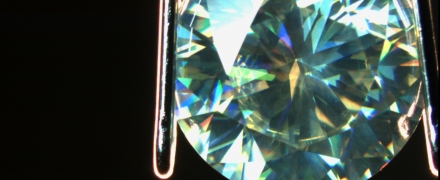open 10 am - 7 pm
laboratory is closed
Birefringence as a diagnostic sign

For the vast majority of minerals found in nature, a manifestation of such a property as birefringence is characteristic. The exception is minerals that crystallize in cubic syngony and therefore exhibit isotropic properties. Birefringence itself, as a physical property, consists in bifurcating a ray that enters the stone, forming two rays with different speeds. Quantitatively, birefringence is equal to the difference between the maximum and minimum refractive indices of these rays. This value has different values for stones, which makes it possible to use the birefringence value or its absence as one of the diagnostic features.
How to see a birefringent mineral or isotropic? The simplest method for observing birefringence is to look at the stone with a magnifier from 10x to 12x. However, only stones with very strong birefringence can be diagnosed this way, for example zircon, sphene, chrysolite or rutile. In the magnifying glass, the ghosting of the edges of the stone should be visible. Sometimes this can be seen when viewing the stone through the platform, but most often this effect is observed when you look at the spike or caletta through the edges of the crown.
More accurate data on the presence and magnitude of the birefringence parameter can be judged after studying the stone with a refractometer. A prerequisite for this is that the sample has a cleaned flat polished surface and its transparency. The refractometer is used to determine the critical angle of the total internal reflection of the stone when the beam passes from a denser medium to a denser one, which we see in the form of shadows on a calibrated scale of the device. Work on the device is carried out with contact liquid, which is called immersion. It has high light transmission and its own refractive index, which will be the limit when working on the device. The rays of light falling on the stone are fully or partially reflected and fall on the scale of the device, creating a shadow. The border of this shadow indicates the refractive index. Depending on the internal structure of the stone, they can be from one to three. When the polarization filter is rotated on the eyepiece of the refractometer, it is possible to see the movement of the shadow border on the scale, if the mineral is not isotropic. The difference between the two extreme positions of the shadows will be the magnitude of birefringence.
В геммологической практике бывают весьма увлекательные случаи с диагностикой ювелирных вставок
Но помимо редкости цвета и высокой стоимости таких камней, многие розовые камни выделяются одной замечательной особенностью – они проявляют плеохроизм, то есть в зависимости от положения осмотра камня он может иметь дополнительные оттенки – оранжевый или пурпурный.
Currently, gemstones are produced by two fundamentally different technological methods - the High Pressure - High Temperature method (“HPHT”, High-pressure & High-temperature) and the Chemical Vapor Deposition (“CVD”, Chemical vapor deposition) method. The "HPHT" method is the most tested classical synthesis method, which can be used both carbon deposition on diamond from flux melts and catalytic reactions. In "CVD" synthesis, diamond growth occurs on a seed during carbon deposition mainly from a gaseous medium at relatively low temperatures and pressures.
Jewelry and precious stones are just such a category of goods, when buying which you need to pay attention to many criteria.
Sogdianite is a rather rare mineral and more often it can be found as a collection material (moreover, in systematic collections), and it is extremely rare in jewelry.






